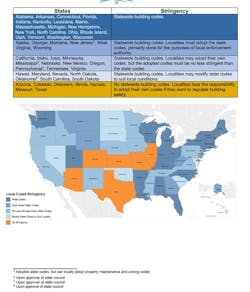One of the few states in the union that has resisted dictating building codes, instead leaving adoption and enforcement decisions to localities, is seeing a renewed push to change course.
In early March, Missouri House legislator Rep. David Casteel introduced the Missouri Building Codes Act, a bill establishing state baseline standards for how structures are built or improved. If passed, codes for key elements of construction, such as electrical, mechanical, and plumbing, would be more uniform across Missouri. That would tame the jumble that now exists, one linked chiefly to varying rates of adoption of updates and revisions at the city and county levels.
The impetus for the bill is a multi-year push by economic development interests in St. Louis to address inefficiencies caused by the frequent presence of non-aligned codes in “authorities having jurisdiction” in the greater metro area. Safer + Simpler Missouri, a group that has been spearheading a push for a state building code, initially using the situation in St. Louis as a springboard, says the current system “causes confusion and higher costs, discouraging investment and growth.” The county’s thicket of codes spanning 89 local governments that use 42 different building codebooks, the group says, presents a singularly difficult challenge for builders, one that is replicated to different degrees across the state.
St. Louis County, and the state of Missouri, generally rank low on measures of stringency when it comes to building codes and their enforcement, as a 2022 report by Safer + Simpler Missouri documented (see Figure below).
With more than two-dozen backers in its coalition, including the National Electrical Contractors Association, Mechanical Contractors Association and the Plumbing Industry Council, Safer + Simpler Missouri says developers, builders and the public would benefit from a more streamlined code environment. Missouri, it says on its website, should join the ranks of most other states that have a superseding, generally top-down state building code framework, one that would ultimately “provide constituents with clarity, consistency, and process transparency.”
Electrical contractors who must navigate the presence of different editions of the National Electrical Code in Missouri jurisdictions would naturally benefit from more uniformity, says Xavier Gassier, director of operations for the St. Louis chapter of NECA. But established St. Louis-area contractors largely know the local codes landscape and have learned the nuances of working within it. Problems arise more, he says, when contractors go outside the area and face a lack of codes, very dated codes, or a maze of code layers and when contractors from outside St. Louis come into the area and encounter its supercharged code confusion.
But from a practical standpoint, Gassier says, the NEC existing as enforceable code in different late editions doesn’t typically present contractors with technical challenges. The two most common editions adopted in St. Louis jurisdictions are the 2014 and 2017 NEC, which are similar enough to not present major interpretation challenges, he says. Outside St. Louis, though, it’s common to see much older NEC editions in force, some as dated as 1995.
“Many smaller jurisdictions in the state have let codes stagnate, and with the presence of dated codes, it’s a bandwidth or attention issue where the staff isn’t equipped to handle the complexities of keeping codes current,” he says. “Generally, though, our concern is less about nuanced technical differences than it is the ability to do business transparently and predictably.”
Even though it’s been advocating for changes for several years, Safer + Simpler Missouri still sees a long road ahead to get legislation in place. One of the main obstacles will be walking the fine line between avoiding building code mandates for jurisdictions that resist them — only 13 of the state’s 114 counties, for instance, have a county-wide building code — and getting more agreement on uniformity for those that already have or agree to adopt them.
“Working through the legislative process is not easy, and building trust in out-state Missouri that will be skeptical will be challenging,” says Charles Hinderliter, the group’s executive director. “Lots of jurisdictions have codes in place, but there are plenty more that don’t, and if that’s the case we’re not going to impose one. The goal is no new regulations, but rather to get on the same code if you have one.”
With all of the challenges involved in gaining buy-in to an entirely new approach that will need as much as possible to make a difference, Hinderliter sees a two- to five-year timeframe for success, meaning the bill just introduced is likely to languish. “We’re having some productive conversations that are building the trust and relationships that we’ll need to get us there.”




